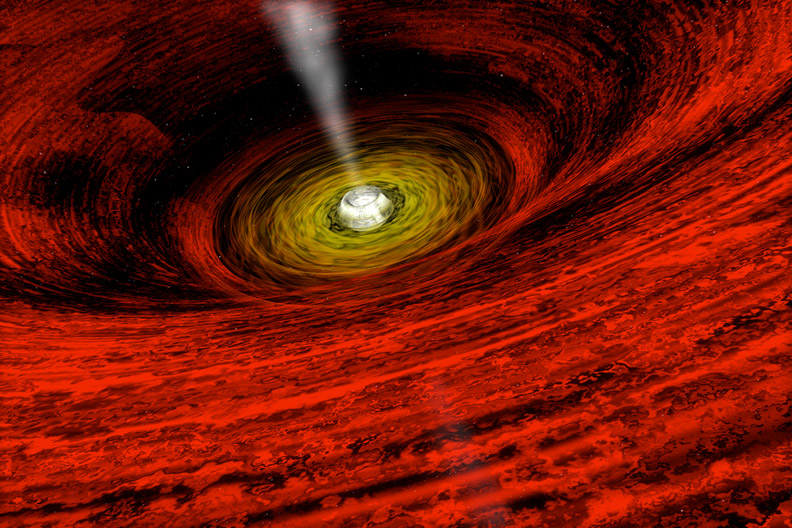…If there exist certain particles of matter not fixed in time- as we perceive ourselves to be fixed in it- then the line between precognition and recognition is more difficult to draw. Arthur Koestler was particularly impressed with the work of Adrian Dobbs, the British microphysicist who proposed a particle he called psitron. Like the neutrino, this as yet hypothetical quantum travels in a different time dimension from ours: not in our visible, deterministic realm but in the dimension of likelihoods.

—Artist’s idea of a black hole, with gas and dust swirling rapidly around it before being pulled in by its powerful gravitational field. You can’t really see the black hole itself.—Read More:http://spaceplace.nasa.gov/black-hole-rescue/
An antenna attuned to the possibilities, though not the inevitabilities, of future events, it absorbs a “pre-cast” that it can communicate to neurons in the human brain. As Koestler pointed out, Dobb’s psitrons are no more or less preposterous than neutrinos. And one day scientific attempts to provide a basis in physics for psychic phenomena may give rise to chimeras even more startling. For it is no longer realistic to assume that identical time situations permeate the cosmos.
The puzzles of time at the atomic level are echoed in the intergalactic level, in the phenomenon of “black holes.” Part of gravitational theory suggests that when a substance becomes dense enough, its gravity turns so violent that the substance is literally crushed out of existence. What holds a star in equilibrium is the balance between gravitational force crushing the star in upon itself and the outward push of heat and radiation from the star’s core. But under certain conditions, gravitational forces may prevail. If they do, the star continues to be crushed inward. Ultimately it becomes so dense that not even light waves can escape its gravity and the star snuffs out, becomes invisible: black.

—Some parapsychologists such as Martin Ruderfer (1974) theorised that tachyons can travel backwards in time and may be able to explain cases of precognition. The British physicist and mathematician Adrian Dobbs (1965) proposed a theory in which precognition occurs due to ‘positrons’ – hypothetical particles similar to tachyons that travel backward in time which may contact an observer’s brain to produce a precognitive experience. The major problem with the tachyon theory of precognition is that tachyons have never been observed to exist; they remain theoretical constructs.—Read More:http://laghash.blogspot.ca/
The gravitational field remains, a black “hole” with no mass, exempt from he traditional laws of time and space. In theory, it may flit through our universe; or it may vanish altogether, reappearing in another space-time continuum in some universe parallel to ours, still carrying the stellar debris it sucks in like a cosmic lamprey. In fact, many scientists, have raised the possibility that quasars- inexplicably fast, energetic objects thought to be racing outward at the far limits of our universe- may actually be matter from black holes in other universes exploding into our own universe.( to be continued)…
ADDENDUM:
(see link at end) Koestler:Yet the history of science has shown over and over again that the fact that a theory “works” and produces tangible results does not prove that the underlying assumptions are correct; and Feymnan’s theory presents formidable logical difficulties, even by the permissive standards of modern micro-physics*. Among various attempts to overcome them is the hypothesis, already mentioned, by Adrian Dobbs**, which introduces two time dimensions, instead of one. A five-dimensional universe with three spatial and two temporal dimensions had already been proposed by Eddington and others; but Dobbs’ theory contains refinements which take into account the unpredictability and indeterminacy of the future in quantum physics. Accordingly, the arrow of time, progressing along the second time dimension, moves through a probabilistic, instead of a deterministic, world; and it resembles less an arrow than a wave front. However, the main interest of Dobbs’ hypothesis lies in his attempt to provide a physicalistic explanation of telepathy and precognition, more sophisticated than any offered before. So sophisticated in fact that it is almost impossible to understand without some working knowledge of quantum theory.Read More:http://www.survivalafterdeath.info/articles/koestler/physics.htm





 COMMENTS
COMMENTS